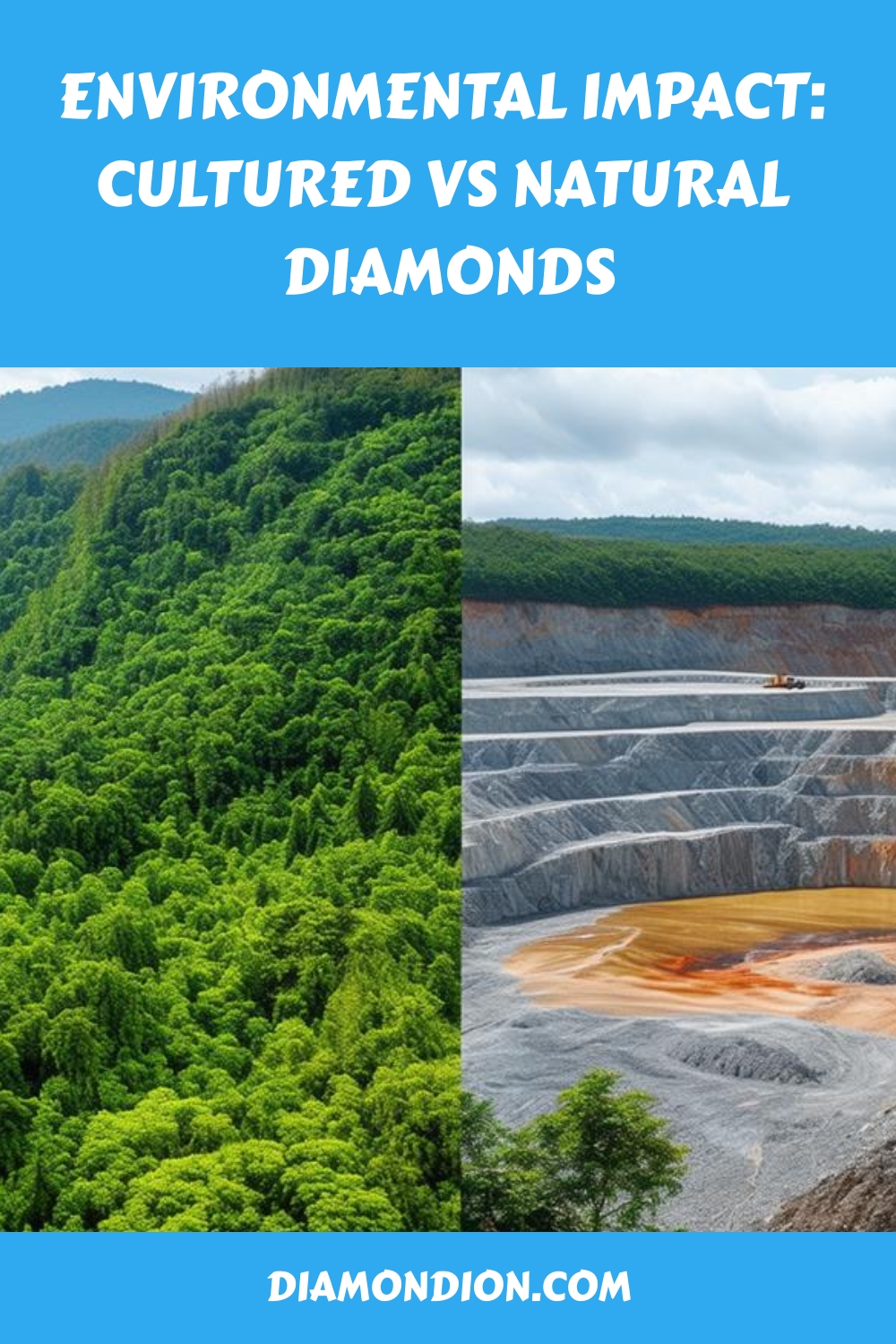Article Contents
The environmental impact of cultured diamonds compared to natural diamonds is markedly different. Cultured diamonds, created using High Pressure High Temperature (HPHT) or Chemical Vapor Deposition (CVD) methods, represent a more sustainable alternative. These technologies consume significantly fewer natural resources and drastically cut water use by up to 99%, alongside producing three times less greenhouse gas emissions per carat than mined diamonds.
Furthermore, the use of renewable energy in the production of lab-grown diamonds bolsters their environmental profile. On the other hand, the extraction of natural diamonds requires extensive land and water resources, leading to greater ecological and ethical concerns.
Continued exploration of this topic will uncover more detailed insights, enhancing the understanding of the environmental implications associated with both diamond types.
Key Points
- Cultured diamonds require up to 99% less water than natural diamonds, promoting water conservation.
- Lab-grown diamonds produce three times less greenhouse gases compared to mined diamonds.
- The extraction of natural diamonds significantly disrupts ecosystems and leads to extensive habitat destruction.
- The use of renewable energy in the production of lab-grown diamonds reduces their overall carbon emissions.
- Traditional diamond mining depletes significant amounts of land and water resources, negatively affecting local ecosystems.
Cultured Diamonds: Production Process
Cultured diamonds are created using either the high-pressure high-temperature (HPHT) technique or the chemical vapor deposition (CVD) process. These techniques accurately mimic the natural conditions under which diamonds form, but do so within a controlled laboratory environment. This control ensures that the diamonds produced are not only of high quality but also uniform in their properties. Furthermore, these laboratories often use sustainable materials and may incorporate renewable energy sources to enhance energy efficiency, reducing the environmental impact of their operations.
The appeal of cultured diamonds lies not only in their visual brilliance but also in their environmentally friendly and ethical production methods. These methods significantly reduce the consumption of natural resources compared to traditional diamond mining. Cultured diamonds exemplify the successful integration of technological advancements with environmental and ethical responsibility. The production techniques have been refined to not only ensure the creation of premium quality diamonds but also to contribute to the preservation of the environment. This approach creates a powerful narrative that promotes an alternative to conventional diamond mining, offering consumers luxury that is both sustainable and responsible. Cultured diamonds thus represent a remarkable achievement in combining aesthetic desires with ecological and ethical considerations.
Natural Diamonds: Extraction Impact
Cultured diamonds offer a more environmentally friendly alternative to natural diamonds, which have a significant negative impact on the environment during extraction. Natural diamond mining involves various methods such as open-pit, underground, and marine mining, each affecting the environment in different ways. Open-pit mining, for example, is particularly harmful as it requires the removal of approximately 250 tons of earth to obtain just one carat of diamond, causing extensive land disruption and habitat destruction for numerous species.
These mining techniques also result in substantial greenhouse gas emissions, further contributing to the environmental damage caused by natural diamond extraction. Despite advancements in mining technology and the introduction of stricter regulations, the environmental consequences remain significant.
The paradox lies in the fact that natural diamonds, often admired for their purity and durability, are obtained through processes that harm the very planet they come from. This conflict calls into question the desirability of natural diamonds, prompting consumers and industry players to consider the complete environmental and ethical implications of these precious stones.
Water Usage Comparison
Lab-grown diamonds significantly reduce water usage compared to mined diamonds, consuming up to 99% less water. This substantial decrease emphasises the environmental benefits of synthetic diamonds, making them a more environmentally friendly choice in the jewellery industry.
Traditional mining methods for natural diamonds, such as open-pit and alluvial mining, use large amounts of water. These methods can deplete local water sources, worsening water scarcity in delicate ecosystems. In contrast, synthetic diamond production requires minimal water, which promotes water conservation and environmental protection.
| Aspect | Water Usage |
|---|---|
| Natural Diamonds | Millions of gallons |
| Cultured Diamonds | Significantly less |
| Impact | Mitigates water scarcity |
Opting for lab-grown diamonds not only fits with luxury but also with a dedication to sustainable practices that focus on water preservation. This decision helps lessen the pressure on natural resources, allowing consumers to enjoy beauty without harming the environment.
Carbon Footprint Analysis
An examination of the carbon footprint of lab-grown diamonds versus mined diamonds shows significant environmental benefits for lab-grown diamonds, especially when produced using renewable energy. These diamonds produce three times fewer greenhouse gases per carat than mined diamonds, highlighting their environmental advantages.
Lab-grown diamonds require energy-intensive machinery for production, which operates continuously. However, the total energy used is still much lower than that required for mining natural diamonds. While the dependence on such machinery presents challenges, the environmental impact is significantly reduced when these operations are powered by renewable energy sources.
Choosing lab-grown diamonds, especially those created with renewable energy, reduces carbon emissions and promotes sustainable luxury goods. This choice allows consumers to contribute to environmental protection and supports the shift towards more responsible and ethical consumption practices, aligning with global trends towards sustainability in the luxury goods sector.
Renewable Energy in Diamond Production
Using renewable energy in the production of lab-grown diamonds significantly enhances their sustainability. Incorporating sources like solar, wind, or hydroelectric power into the manufacturing process marks a critical shift towards eco-friendlier operations. This transition not only promotes energy efficiency but also emphasises the environmental advantages, reflecting a commitment to conserving the natural environment for future generations.
The adoption of renewable energy significantly lowers the carbon footprint associated with lab-grown diamonds. The equipment used in diamond synthesis typically requires high energy, operating under extreme heat and pressure. By converting these systems to renewable energy, the industry not only makes an environmental statement but also adopts a progressive stance on resource use that honours both the planet and the choices of consumers who prioritise sustainability.
This shift towards sustainable practices extends beyond merely adhering to regulations or following market trends; it is an active move to reshape the perception of luxury goods through a lens of responsibility and innovation. Consumers interested in both style and sustainability can take pride in their choices, knowing they are reducing environmental impact. This development ushers in an era where luxury and sustainability coexist, fully integrated and mutually reinforcing.
Frequently Asked Questions
Are Natural or Synthetic Diamonds Better for the Environment?
Artificial diamonds are frequently viewed as being more environmentally friendly than real diamonds because they require less mining, resulting in lower emissions and water consumption. This helps reduce the ecological impact and depletion of resources.
Do Lab-Grown Diamonds Affect the Environment?
Lab-grown diamonds impact the environment primarily due to their significant energy requirements and associated carbon emissions. However, the increasing integration of renewable energy sources in their production processes is helping to reduce these environmental effects.
What are the most environmentally friendly diamonds?
The most environmentally friendly diamonds are those that are created using renewable energy sources. This method significantly reduces the environmental impact by decreasing carbon emissions. Additionally, these diamonds are made in accordance with stringent environmental regulations, guaranteeing sustainable practices. These diamonds are sought after by consumers who value ethical and eco-friendly products.
Are lab-grown diamonds more ethical than natural ones?
Lab-grown diamonds are considered more ethical than natural diamonds due to their transparent production process and the absence of labour abuses often associated with natural diamond mining.
Summary
In summary, the transition from diamonds mined naturally to laboratory-grown diamonds represents a significant move towards sustainability and innovation in the jewellery industry.
Lab-created diamonds provide a more environmentally friendly option by reducing the significant ecological harm linked with traditional diamond mining.
By using renewable energy and modern technology, the industry is now moving towards a future where luxury is in harmony with environmental responsibility, offering a greener and more dazzling future for everyone.



